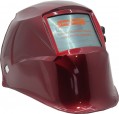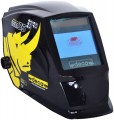Protection from UV/IR
The degree of protection against infrared and ultraviolet radiation provided by the complete mask light filter.
Such protection is relevant primarily when working with electric welding: it is the electric arc that produces a large amount of IR and UV radiation. Exposure to these types of radiation on the skin can cause burns, and ultraviolet light is also harmful to the eyes. The degree of protection in this case is indicated in DIN units, and the larger the number in such a designation, the higher the degree of protection. In this case, 12 DIN is considered the minimum acceptable indicator, however, masks / goggles can be found on the market with higher protection rates — up to 16 DIN inclusive.
From a purely practical point of view, the higher this level of protection, the better; however, this characteristic significantly affects the price, and sometimes also the weight of the mask / goggles. So when choosing, it is worth considering the features of the planned work. For example, it is hardly worth specifically looking for a model for 15 – 16 DIN, if you have to cook rarely and little by little, but for professional use and large volumes of work, this level of protection will be very useful.
Turn-on time
The turn-on time of the filter in the chameleon mask (see "Type"), in other words, the time between striking the arc and darkening the filter to the operating level.
From a safety point of view, the turn-on time should be as short as possible: the faster the "chameleon" works, the less bright light from the arc enters the welder's eyes. On the other hand, reducing the reaction time affects the cost of the product. So for relatively small volumes of work, it is quite acceptable to use relatively “slow” masks — for
100 μs or more(especially since even in the simplest models, the reaction time does not exceed 1200 μs, while theoretically the maximum allowable value is 2000 μs). But for more serious use, you should pay attention to more "fast" options; nowadays, you can find masks with response times
from 75 to 100 µs,
from 50 to 75 µs, and even
less than 50 µs.
Filter class
Class is a complex indicator that determines the overall quality of the light filter in a chameleon mask (see "Type"). The class is indicated by 4 numbers, each of which describes a specific optical parameter. So, the first number indicates the overall clarity and lack of distortion; the second is the degree of light scattering; third — uniformity of blackout (presence/absence of visible blackout spots); the fourth is the angular dependence (how much the filter brightens when the angle of view deviates from the perpendicular). In each case, the larger the number, the worse this parameter is. The perfect indicator is considered to be 1/1/1/1, but in fact it is very difficult to achieve an perfect angular dependence, and there is no need to. Therefore, an indicator of 1/1/1/2 is considered quite sufficient even for a high-end professional filter.
Filter cartridge dimensions (WxH)
The overall dimensions of the light filter for which the mask is designed, taking into account the working window, protrusions for mounting, batteries, sensors and other structural elements. This indicator is especially important for models that are not equipped with light filters: without knowing the size, it is very difficult to choose the right cartridge. In other cases, data on the size of the cartridge is needed mainly when looking for a replacement for a failed colour filter.
Darkening adjustment
The ability to manually select the degree of darkening of the filter in the chameleon mask. This feature is found mainly in professional models; it allows the welder to manually adjust the light transmission for specific conditions. The need
to adjust the dimming is due to the fact that for some types of work (for example, TIG welding of ferrous metals), the brightness of the arc is relatively low, and in order to see the weld pool normally, dimming of only 8-9 DIN is enough instead of the usual 12 DIN or more .
Sensitivity adjustment
The ability to change the sensitivity of the sensors responsible for the operation of the light filter in the "chameleon". Thanks to this function, you can adjust the filter in such a way that it is guaranteed to turn on from the arc and at the same time does not react to extraneous light sources.
sensitivity adjustment is especially useful when there is numerous extraneous "flare" (for example, when several welders work close to each other, in bright sunlight, etc.).
Delay time adjustment
The ability to manually set the delay time between the disappearance of the arc and turning off the filter in the chameleon mask. Such a delay is highly desirable in the light of the fact that even after the arc is turned off, the heated metal continues to glow for some time; therefore, it is advisable not to turn off the filter immediately.
Adjusting the delay time allows the welder to independently choose the time to return to the non-working (maximally transparent) state.
Grinding mode
A special mode of operation of the chameleon mask, in which the light filter sensors are completely turned off — thus, it constantly remains transparent and does not respond to any flashes. This mode is useful for jobs that can produce fairly bright flashes of light, but do not require dimming. A classic example of such work is grinding with a “grinder” or a machine tool, when sparks can fly from the workpiece; hence the name of this function —
"grinding" mode.
Design features
— Backlight. Illumination system built right into the mask. This feature is very convenient when working in low light conditions: the backlight does not take up the hands (unlike hand-held flashlights) and does not create problems with wearing a mask (unlike headlamps), while the beam of light is always directed to where the welder's head is turned. On the other hand, such a system requires its own power supply. Therefore, it is used only in "chameleons", while the operation of the backlight additionally consumes battery power.

